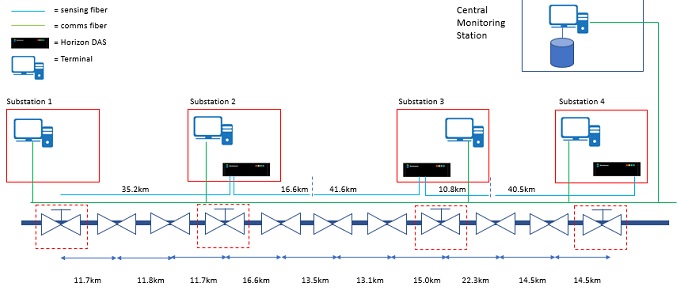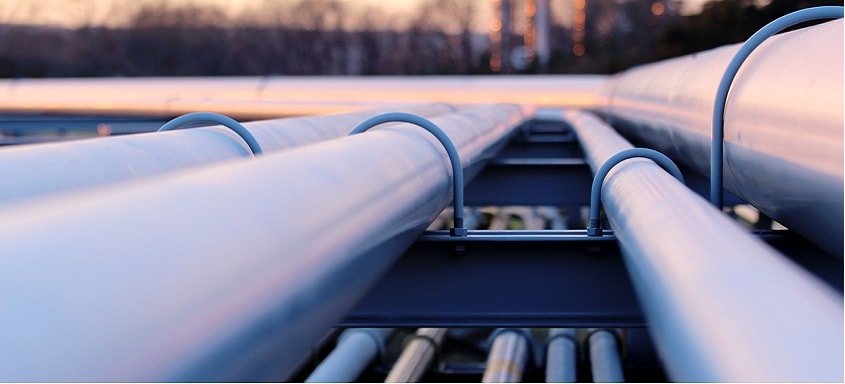A recent installation of a Fiber Optic Pipeline Intrusion Detection Systemwas applied to the 145km extension of an underground natural gas pipeline to prevent potential damage and leaks through real time data monitoring.
The world consumption of natural gas increases by an average of 1.7% each year for industrial uses, and 2.2% for the electrical power sectors. With this continual increase in demand comes the necessity for efficiency and reliability, as well as for efforts to minimise losses of gas occurring during the transmission and distribution processes.
Gas pipeline leakage is a worldwide issue, with a report published in 2015 revealing an estimated 3.6 trillion cubic feet of natural gas escaped into the world’s atmosphere from global gas and oil operations in that year alone. This wasted gas equates to roughly $30 billion of lost revenue and about 3% of global natural gas production. These figures are not only substantial from a financial perspective, but also an environmental one, as methane emitted from leaking pipes contributes to the world’s growing global warming problem.
Whilst the primary cause of gas pipeline leakages continues to be the ageing of pipeline infrastructure, the most significant leaks that occur are caused by damage from nearby excavation equipment. According to data published by the Pipeline and Hazardous Materials Safety Administration, out of 925 incidents which occurred in gas distribution pipeline networks between 2010-2018 in the USA alone, 270 were a result of excavation damage.Of this number, 85% were caused by third-party interference.
To minimize damage to people, costs of repair, cost of renovation and lost revenue, pipeline monitoring is crucial.
Currently, leak detection systems can be categorised into 2 major types; continuous and non-continuous systems. Non-continuous systems include methods such as helicopter tracking,which utilises infrared cameras to locate leaking spots, or‘smart pigging’, where a ‘pig’ is launched through the pipe and gathers data along the way using ultrasonic technology.Patrolling the pipeline, and dog tracking, where trained dogs are led along the pipe and are able to recognise the odour of leaking compounds are also amongst the traditional pipeline monitoring methods.

The main issue with non-continuous systems is that whilst they provide reliable leak detection, they have no utility regarding leak prevention. In contrast, continuous leak detection systems, such as distributed acoustic sensing, providethe additional benefit of being able to detect potential threats before they manifest into much larger, much more expensive issues.
In the case of the Asian gas supplier, Guangdong Natural Gas Group (GDNGG), fiber optic sensing has proved to be a highly accurate, reliable and cost-effective tool, which can not only detect leaks with precise location identification, but also, when paired with Maxview Integration Software, alarms personnel to events occurring around the pipeline – proactively preventing damage.
GDNGG were constructing an additional 145km section of natural gas pipeline for increased supply to an urban area. The pipeline was buried in a trench to a depth of 1.5m, with a fiber optic telecommunications cable buried in the same trench. The area around the pipeline was a heavy traffic construction zone, and the company was concerned that other unapproved construction activities by third-party companies may risk damage to the pipeline.In order to protect the pipeline from any potential damage, GDNGG commissioned a global supplier of distributed optical sensing solutions to supply a distributed acoustic sensing system to monitor surrounding third-party construction activity.
This pipeline intrusion detection system incorporated multiple Horizon DAS systems based at block valve stations along the pipeline. These are fiber optic-based optoelectronic instruments which measure acoustic interactions along the length of the fiber optic sensing cable.
Ahead of the deployment, it was necessary to undertake a detailed site survey. This resulted in dividing the area of pipeline into zones of similar characteristics, such as, for example, areas of particular ground hardness. Factors of this type would influence the acoustic activity, meaning the detection algorithm for each zone would differ.
A crucial part of the project installation was the real-life tests whichprovided valuable information on the acoustic sensitivity. Based on the data obtained, the sensing algorithms were then adjusted accordingly to match the sensitivity and activity of the general environment.
The system far exceeded the measurement requirements and was able to detect mechanical excavation from distances between 30m to 70m, although the specification was only to detect the events within 20m of the pipeline. Following the successful testing and commissioning period, the active operation was initiated.
During the operation of the system, the construction activity in the area was extensive and resulted in 96 raised alarms during the first two months. 90% of those events were verified by the patrol teamsdispatched to investigate as construction events taking place too close to the pipeline.
One of the alarms directly prevented damage to the pipeline when the patrol team was alerted to a mechanical excavation activity straight above the pipeline. A third-party excavator had dug to a depth of 0.3m and had damaged one of the control cables. The accurate data and prompt reaction prevented the machinery from further digging to the level of the pipeline (a depth of 1.5m) and catastrophic damage was avoided.
Richard Kluth, the Managing Director of Bandweaver –provider of the fiber optic sensing system, commented, “The pipeline monitoring system based on Horizon DAS provides coverage of the entire pipeline, at all points along the length. Because the Horizon DAS has 2 channel capability, it is able to measure up to 100km for each system (50km in each direction). This long-range capability provides a cost-effective system with a high return on investment.”
This operation fully conveyed how a fiberoptic pipeline intrusion detection system can benefit the gas and oil industry, principally thanks to the high-accuracy, low nuisance alarm level and reliability. Preventing damage, and consequently leaks, before they occur not only saves companies thousands of dollars in man-hours and rectification efforts, but also protects human life, the environment and the reputation of the companies who employ its use.
When considering the additional litigation risks, it is clear that an intelligent pipeline monitoring system is critical and should be included in all proactive asset protection strategies.
 Richard Kluth – Managing Director
Richard Kluth – Managing Director
Richard has more than 20 years’ experience in applying monitoring and instrumentation technologies in a wide variety of industries including upstream and downstream oil and gas, electrical power and fire and security. Working for companies including Schlumberger, Shell Technology Ventures, Sensornet, Acteon and Bandweaver, Richard has been responsible for introducing a range of new sensing technologies including the first downhole fiber optic sensing system to the oil and gas industry. Richard is based in the Bandweaver UK office
For more information, visit www.bandweaver.com or contact info@bandweaver.com
Additional resources:
- https://www.eia.gov/outlooks/ieo/pdf/nat_gas.pdf
- http://rhg.com/wp-content/uploads/2015/04/RHG_UntappedPotential_April2015.pdf
- https://www.phmsa.dot.gov/data-and-statistics/pipeline/distribution-transmission-gathering-lng-and-liquid-accident-and-incident-data
- https://www.bandweaver.com/products/horizon-das/


































